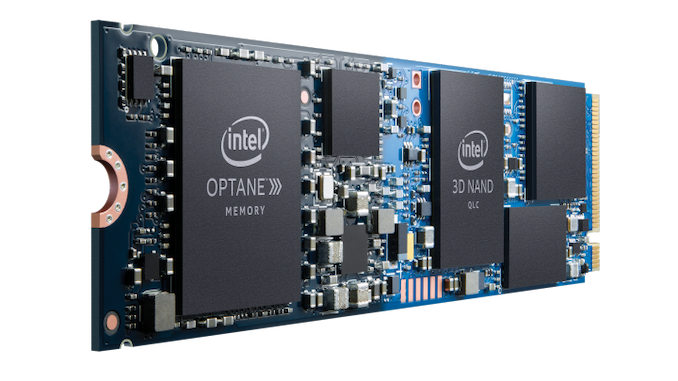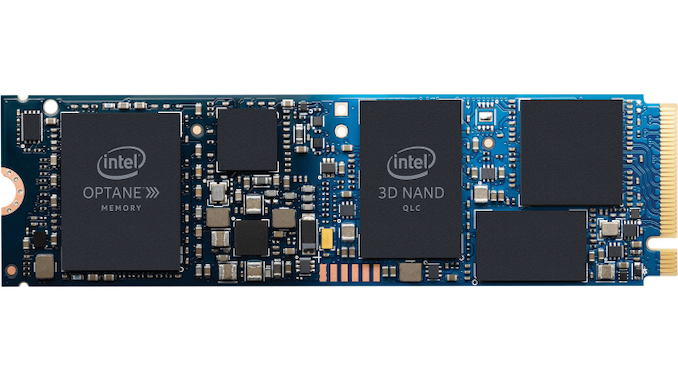New Generation of Optane M.2 SSDs Coming Soon
by Billy Tallis on January 8, 2019 2:30 PM EST
Intel's Optane products so far fall into one of two categories. At the high end is the flagship P4800X enterprise SSD and its derivatives for the enthusiast market. At the low end are the small M.2 modules intended primarily for caching use. It's this latter category that is being upgraded from PCIe 3x2 to a PCIe 3x4 host interface, moving the cache drives and small Optane SSDs more toward the mainstream NVMe SSD market.
Based on leaked roadmaps, we know that the original Optane Memory and its refresh Optane Memory M10 are being replaced by the new Optane Memory M15, codenamed Carson Beach. The Optane SSD 800P is being replaced by the new Optane SSD 815P, codenamed Bombay Beach. Capacity options are changing slightly for the M15 cache modules, which offer 16GB to 128GB in M.2 2280 form factor and 16GB to 64GB in M.2 2242 size. The Optane SSD 815P will be available in the same 58GB and 118GB capacities as the 800P.
| Intel Optane Consumer M.2 Product Lineup | ||
| First Generation | Second Generation | |
| Caching Modules | Optane Memory (16GB, 32GB) Optane Memory M10 (16GB, 32GB, 64GB) |
Optane Memory M15 (16–128GB, PCIe 3x4) |
| Standalone SSD | Optane SSD 800P (58GB, 118GB) |
Optane SSD 815P (58GB, 118GB, PCIe 3x4) |
| Hybrid NAND+Optane | Optane Memory H10 16GB+256GB, 32GB+512GB, 32GB+1TB PCIe 3 x2+x2 |
|
It appears that Intel is continuing with the rather confusing mismatch of advertised capacities between the Optane Memory and Optane SSD products. In reality, the Optane Memory 64GB and Optane SSD 58GB products have the exact same usable capacity, and the same will hold true for the 128GB vs 118GB. The smaller advertised capacities are more in line with how SSD vendors traditionally relate claimed GB to actual usable capacity, while the Optane Memory parts are advertising the nominal raw capacity of their 3D XPoint memory without reflecting space used for error correction or spare area for defect and wear management.
The system requirements for the above Optane products are unchanged from their predecessors. Optane Memory caching requires a Kaby Lake or newer platform and the use of Intel's Optane Memory storage drivers for Windows. Otherwise, both the M15 and 815P are standard NVMe SSDs that can be used as regular data or boot drives in any system that supports flash-based NVMe SSDs.
The third new Optane product is by far the most interesting: the Optane Memory H10 with Solid State Storage, codenamed Teton Glacier. Where previous Optane Memory products have been intended to serve as a cache in front of a mechanical hard drive, the H10 is Optane caching for QLC NAND, with both 3D XPoint and flash memory on the same M.2 module. The H10 bundles 16GB of Optane cache with 256GB of QLC NAND, or 32GB cache with 512GB or 1TB of QLC.
So far, Intel has only shared a mock-up rendering that looks like an Intel 660p and Optane Memory module squeezed onto one M.2 2280 card, but with enough changes to the layout that it doesn't appear to be just a photoshop of images of the two existing products. The first half of the board appears to contain the same Silicon Motion SM2263 controller used on the 660p, and one package each of DRAM and QLC NAND. The second half of the board looks like an existing Optane Memory module, with its own controller and 3D XPoint memory packages. We're not sure if this photo is an accurate representation of the real product, but it indicates that two PCIe lanes are routed to the SM2263 controller and two to the Optane controller. This suggests the Optane Memory H10 will appear to the host system as two different NVMe SSDs, and will likely require PCIe port bifurcation support to operate a PCIe x4 M.2 slot as two PCIe x2 links. This could potentially limit compatibility to M.2 slots that use PCIe lanes provided by the PCH. Officially, the Optane Memory H10 will require a Whiskey Lake or Coffee Lake platform. Unofficially, this may be the first Optane product that doesn't work out of the box as a plain NVMe SSD on any platform that supports NVMe. The dual-controller nature of the H10 means that the SSD caching functionality still depends on driver software, and is not managed transparently by the SSD itself. Intel will have to develop a unified 3D XPoint+3D NAND controller to pull that off.
Intel has not formally announced the M15 or 815P, but they have put up a product page for the H10. The Optane Memory H10 is planned for release in Q2 2019 with OEM systems from the usual suspects: Dell, Lenovo, HP, Acer, ASUS, and unspecified others. We expect the M15 and 815P to arrive at the same time or sooner.
Source: Intel











27 Comments
View All Comments
Mikewind Dale - Tuesday, January 8, 2019 - link
"the H10 is Optane caching for QLC NAND, with both 3D XPoint and flash memory on the same M.2 module"That's really awesome. That could mitigate the low endurance (TBW) of QLC, by having all writes first go to the XPoint and later be folded over to the QLC. That might reduce write amplification, and therefore, extend endurance somewhat.
"This suggests the Optane Memory H10 will appear to the host system as two different NVMe SSDs, and will likely require PCIe port bifurcation support to operate a PCIe x4 M.2 slot as two PCIe x2 links."
Well, bummer. That just spoils it.
If Intel develops a QLC SSD with an XPoint cache that reduces write amplification and extends endurance, while transparently appearing to the system as a single, ordinary SSD, then I'm sold.
CheapSushi - Tuesday, January 8, 2019 - link
Ah darn, I was excited about it but it does indeed kill the interest for me. I would love to use it for warm cache on my rigs.TelstarTOS - Sunday, February 24, 2019 - link
"If Intel develops a QLC SSD with an XPoint cache that reduces write amplification and extends endurance, while transparently appearing to the system as a single, ordinary SSD, then I'm sold."They will, but how real-time performance would be better than a good TLC drive with a hefty SLC cache (such as the evo plus)? It would be worth it only if (A) steady state performance is higher and (B) price is lower. I highly doubt this, after having seen the terrible performance that QLC drives have.
ikjadoon - Tuesday, January 8, 2019 - link
I've said it once and I'll say it again.Intel should, if they can, package 3D XPoint for on-device storage for high-end consumer devices: , GoPro's & drones, cell phones, hand-held consoles, etc. TLC over the years, especially for 4K/8K video write/delete/write cycles, can't be healthy. And you can't beat the random performance of Optane at low QD for phones & hand-held consoles.
Billy Tallis - Tuesday, January 8, 2019 - link
Write endurance isn't really a problem for sequential video recording; TLC or MLC is adequate depending on the use case, and cheaper than 3D XPoint. But I would absolutely love to have it in my phone. I'd rather have 64GB of 3D XPoint than 512GB of flash in my phone.ikjadoon - Tuesday, January 8, 2019 - link
On video recording: really? Maybe I'm taking Samsung's 64L TLC endurance lightly, but it seems just 2 years of ~2 hours of 40GB/hour (roughly 100Mbps) per day for a 64GB card. Maybe a bigger issue than I suspected. And,eh, I forgot that people still use MLC. Samsung actually did just that for their continuous-recording microSD Card, which uses 64L MLC.But, yes. In phones/tablets, it'd be killer...This is how you could justify your prices, Apple. ;)
CheapSushi - Tuesday, January 8, 2019 - link
One issue with Xpoint, aside from price of course, is that it uses significantly more power, at idle and usage, than NAND drives. So it could be a problem on smaller devices with lower capacity batteries. Although, it still is an NVMe 1.3 device thus can have very low power states.IntelUser2000 - Tuesday, January 8, 2019 - link
Actually the Optane Memory M10 devices are efficient enough in laptops that it gets decent battery life despite being used as a cache.You don't need a ton of throughput in a phone anyway, so it might just work. Though if you want to go for 64GB 3D XPoint, its better to wait until it works as a complement to RAM, so its like having 64GB of RAM. Then you can have nearly instantaneous boot and loads and get away with having small about of RAM, maybe 1-2GB.
ikjadoon - Wednesday, January 9, 2019 - link
Pardon? XPoint uses much less power than SSDs on load.https://www.pcper.com/reviews/Storage/Intel-Optane...
It's 60% less than an average NVMe M.2 Drive on load. While Idle power is 40% more than the average now, it could certainly be optimized for lower idle draw. They have no inherent reason for a 1.2W idle draw and Intel has swaths of experience in reducing idle draw (the entire Ultrabook market).
808Hilo - Thursday, January 10, 2019 - link
Optane still does not make sense. RAM and Storage are the same and should be packaged on the same die. Right now we are supposed to pay double and triple for slow products on a bus. An external bus means SLOW. A Ryzen 16 core with 1tb of near shared graphics/cache/ssd would be very interesting. Optane is just old, useless and value adding only to Intel.